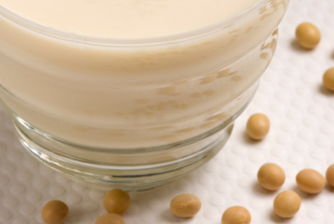
| Soymilk is an excellent source of protein. |
Everything You Ever Wanted to Know About the Soybean
What is a Soybean?
Originating in East Asia, the soybean is part of the legume family. Of a soybean’s approximate total dry weight, 60% is strictly protein and oil, with protein accounting for 40% and oil for 20%. 35% is carbohydrate and the remaining 5% is moisture.
The word ‘soy’ comes from the Japanese word, ‘shoyu’.
How Does the Soybean grow?
The soybean grows on a plant with a height that ranges from below 20 centimetres up to 2 metres. The plant’s stems, pods and leaves are covered with tiny brown or grey hairs.
Soybeans grow to be a variety of sizes and their shell coatings (referred to as the hull) can be brown, black, yellow, green, blue and speckled. The part of the plant which contains the seeds (called the fruit) is a hairy pod, usually growing in clumps of 3-5, with 2-4 beans inside each one. Each soybean can be anywhere from 5 to 11 centimetres in length.
The Soybean as a Complete Protein
As a rule, legumes tend to be higher in protein than other plant-based foods, and yet the vast majority of legume proteins are still slightly deficient in two amino acids. In order to be classed as a ‘complete protein’ a food must contain a significant amount of every essential amino acid. Many qualified health bodies consider the soybean to be a complete protein.
According to the Protein Digestibility Corrected Amino Acid Score, soy protein is equivalent to that found in meat and eggs when it comes to human growth and health. Remarkably, the soybean has the ability to produce twice as much protein per acre than any other grain or primary vegetable.
History of the Soybean
As a crop, the soybean was critical to Eastern Asia far before records were even made. Today, it is still a primary crop in Japan, Korea and China. Soy was introduced to Europe in the late 18th Century, to Africa in the late 19th Century, and to the United States in 1765. Before the 1920’s the United States used soy exclusively as an industrial product, and it wasn’t until after this date that soy was considered a food. “A Few Dozen India Soy” (soy sauce) was the first soy product to arrive in Canada in 1831. It is believed that soybeans were grown in Canada by the time 1855 arrived.
Healthy Attributes and Benefits
The soybean is known for its positive nutritional characteristics:
• High in protein
• High in fibre
• Low in fat
• Contains omega-6 fatty acids
Going one step further, a wide range of studies demonstrate numerous possible health benefits of consuming soy:
• The isoflavones in soybeans are said to be helpful in the prevention of certain cancers (prostate, breast and colon), and also may slow the onset of osteoporosis, and alleviate symptoms of menopause
• Approved by the Food and Drug Association (FDA), soy is recognized as a food which lowers cholesterol
• Soy protein, when consumed in an amount of 25 grams per day, can reduce the risk of heart disease (FDA)
• With high levels of phytic acid, the soybean has been claimed to reduce cancer, minimize diabetes and reduce inflammation
Soy as Milk
Soymilk is made through the process of soaking dry soybeans and then grinding them down with water. The result is a mixture consisting of oil, water and protein, the latter of which represents the same amount as that found in cow’s milk (approximately 3.5%). In addition to protein, soymilk also consists of 2.9% carbohydrate, 2% fat and 0.5% ash. In contrast to cow’s milk, soymilk contains no cholesterol and very little saturated fat.
As a healthy alternative to cow’s milk, soymilk is:
• Lacking casein therefore safe for those with lactose intolerances or milk allergies
• Source of Vitamin E and lecithin
• High in protein and fibre

